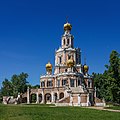Naryshkin baroque
The Naryshkin Baroque , also called Moscow Baroque , is a style of architecture that was popular in central Russia around 1700.
The Naryshkin Baroque is a fusion of traditional Russian architecture with elements of the Baroque that were introduced from Central Europe via the Ukrainian Baroque . It stands in contrast to the Petrine Baroque , which is clearly more western oriented , the most famous examples of which are the Peter and Paul Cathedral in Saint Petersburg and the Menshikov Tower in Moscow .
The first churches in this baroque style were built on the property of the wealthy Naryshkin family , from which the mother of Peter the Great Natalia Kirillovna Naryshkina came. They were mostly made of red brick and decorated with white stone. The bell tower was no longer placed separately, as was customary in Russia until the 17th century, but integrated into the facade. It surmounted the octagonal central element.
However, the style was soon no longer limited to the properties around Moscow, but spread throughout the country. Many monasteries were redesigned according to the new fashion, including the well-known Novodevichy and Donskoy monasteries . The main architects associated with the Naryshkin style are Jakow Buchwostow and Pyotr Potapov.
In the 1730s, the Naryshkin style gradually gave way to the Elizabeth Baroque , the main representative of which was the court architect of Tsarina Elisabeth Bartolomeo Rastrelli .
Web links
- Description of the style on temples.ru (Russian)
- Description on architectural-styles.ru (Russian)


